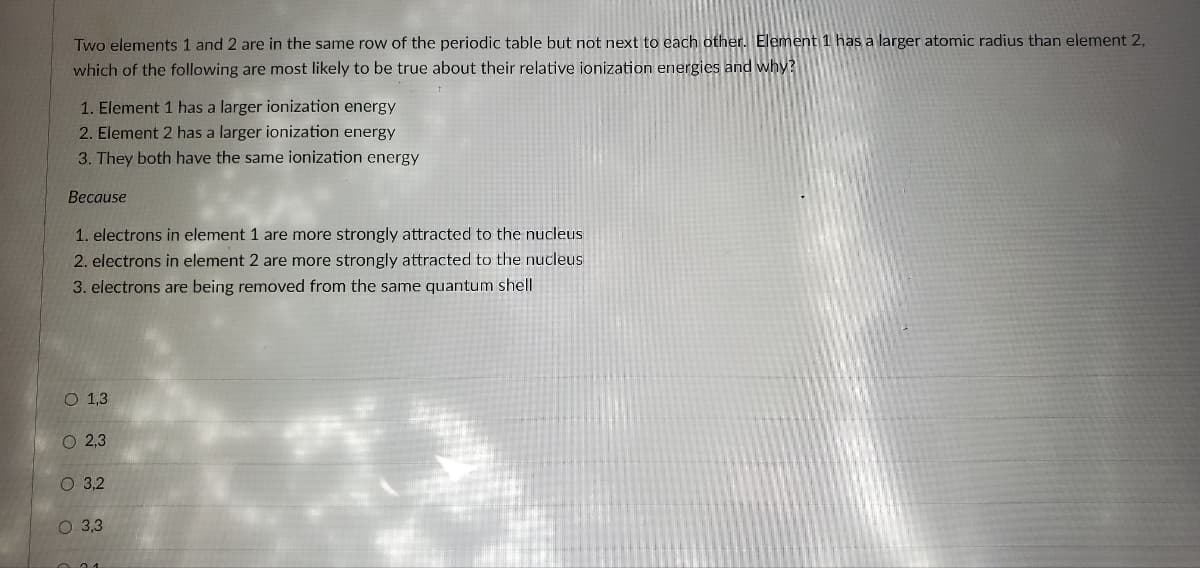Two elements 1 and 2 are in the same row of the periodic table but not next to each other. Element 1 has a larger atomic radius than element 2, which of the following are most likely to be true about their relative ionization energies and why? 1. Element 1 has a larger ionization energy 2. Element 2 has a larger ionization energy 3. They both have the same ionization energy Because 1. electrons in element 1 are more strongly attracted to the nucleus 2. electrons in element 2 are more strongly attracted to the nucleus 3. electrons are being removed from the same quantum shell O O O O O 1,3 O 2,3 O 3,2 O 3,3
Two elements 1 and 2 are in the same row of the periodic table but not next to each other. Element 1 has a larger atomic radius than element 2, which of the following are most likely to be true about their relative ionization energies and why? 1. Element 1 has a larger ionization energy 2. Element 2 has a larger ionization energy 3. They both have the same ionization energy Because 1. electrons in element 1 are more strongly attracted to the nucleus 2. electrons in element 2 are more strongly attracted to the nucleus 3. electrons are being removed from the same quantum shell O O O O O 1,3 O 2,3 O 3,2 O 3,3
Chemistry for Engineering Students
4th Edition
ISBN:9781337398909
Author:Lawrence S. Brown, Tom Holme
Publisher:Lawrence S. Brown, Tom Holme
Chapter6: The Periodic Table And Atomic Structure
Section: Chapter Questions
Problem 6.82PAE: 6.82 A particular element has the following values for its first four ionization energies: 900,...
Related questions
Question

Transcribed Image Text:Two elements 1 and 2 are in the same row of the periodic table but not next to each other. Element 1 has a larger atomic radius than element 2,
which of the following are most likely to be true about their relative ionization energies and why?
1. Element 1 has a larger ionization energy
2. Element 2 has a larger ionization energy
3. They both have the same ionization energy
Because
1. electrons in element 1 are more strongly attracted to the nucleus
2. electrons in element 2 are more strongly attracted to the nucleus
3. electrons are being removed from the same quantum shell
OOOO
O 1,3
O 2,3
O 3,2
O 3,3
Expert Solution
This question has been solved!
Explore an expertly crafted, step-by-step solution for a thorough understanding of key concepts.
Step by step
Solved in 4 steps

Knowledge Booster
Learn more about
Need a deep-dive on the concept behind this application? Look no further. Learn more about this topic, chemistry and related others by exploring similar questions and additional content below.Recommended textbooks for you

Chemistry for Engineering Students
Chemistry
ISBN:
9781337398909
Author:
Lawrence S. Brown, Tom Holme
Publisher:
Cengage Learning

Chemistry: Principles and Reactions
Chemistry
ISBN:
9781305079373
Author:
William L. Masterton, Cecile N. Hurley
Publisher:
Cengage Learning

Chemistry: The Molecular Science
Chemistry
ISBN:
9781285199047
Author:
John W. Moore, Conrad L. Stanitski
Publisher:
Cengage Learning

Chemistry for Engineering Students
Chemistry
ISBN:
9781337398909
Author:
Lawrence S. Brown, Tom Holme
Publisher:
Cengage Learning

Chemistry: Principles and Reactions
Chemistry
ISBN:
9781305079373
Author:
William L. Masterton, Cecile N. Hurley
Publisher:
Cengage Learning

Chemistry: The Molecular Science
Chemistry
ISBN:
9781285199047
Author:
John W. Moore, Conrad L. Stanitski
Publisher:
Cengage Learning

General Chemistry - Standalone book (MindTap Cour…
Chemistry
ISBN:
9781305580343
Author:
Steven D. Gammon, Ebbing, Darrell Ebbing, Steven D., Darrell; Gammon, Darrell Ebbing; Steven D. Gammon, Darrell D.; Gammon, Ebbing; Steven D. Gammon; Darrell
Publisher:
Cengage Learning

Chemistry: An Atoms First Approach
Chemistry
ISBN:
9781305079243
Author:
Steven S. Zumdahl, Susan A. Zumdahl
Publisher:
Cengage Learning
